Metamaterial Lenses
November 18, 2019
One measure of the importance of a
technology is how many instances you have in your
home. By that measure, the
transistor easily takes first place, since the
integrated circuits in your
cellphones,
computers, and other devices contain many billions of transistors. If we come up from the
nanoscale to something about the size of common
fruits, overlooking the many instances of
advanced material items made of
glass,
metal, and
plastic, the
electric motor is a likely second to the transistor. Electric motors are a part of your
refrigerator,
hair dryer,
home appliances, and even the
device that vibrates your cellphone.
Your
household likely contains at least as many
optical lenses as electric motors. My
eyeglasses have two lenses that allow me to more easily write this article, and there are lenses in
cellphone cameras,
tablet computer cameras, and
laptop computer cameras. If a household member uses
disposable contact lenses, the number of contact lenses in a single box will alone outnumber the electric motors.
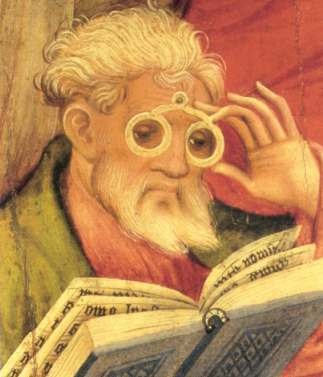
Optical lenses have been known from antiquity, but the apparent first mention of their use as a corrective lens is in Pliny the Elder's description of the Roman emperor Nero's use of an emerald as a vision aid.[1]
Roger Bacon discussed the scientific principles behind the use of corrective lenses in Part V of his c.1266 Opus Majus.[2]
(The Glasses Apostle, a 1403 painting by Conrad von Soest (c. 1730 - c. 1422), considered to be the oldest depiction of eyeglasses north of the alps, via Wikimedia Commons.)
Early lenses were made from glass by the
protracted process of
grinding and
polishing flat, or
near-net-shape, pieces into the required shape and high
surface finish. The lenses of in the devices of today are
cast from high
refractive index epoxy gels in precision
molds with a subsequent
thermal reflow process. However, one effective lens from
antiquity, the
pinhole lens didn't need a refractive material to function. If
light rays are constrained to pass through a small opening, they will project an
inverted image on a
wall or
screen.
Such a room having a small opening to admit light, called a
camera obscura, was supposedly known to the
Greek philosopher Aristotle (384 BC-322 BC). This pinhole lensing is described in Book XV, chapter 6, of his "
Problems." In the
Problems, Aristotle writes how the image of the
Sun, projected through the
rectangular holes of a
wicker basket, still maintains its
circular shape in the image projected onto the ground.[3]
"Why does the Sun penetrating through quadrilaterals form not rectilinear shapes but circles, as for instance when it passes through wicker-work? Is it because the projection of the vision is in the form of a cone, and the base of a cone is a circle, so that the rays of the sun always appear circular on whatever object they fall? For the figure also formed by the sun must be contained by straight lines, if the rays are straight; for when they fall in a straight line on to a straight line, they form a figure contained by straight lines. And this is what happens with the rays."[3]
Just slightly more complex than a hole in a wall is a lens formed by
water in a
spherical glass
vessel. This type of lens, used as a
burning glass in antiquity, was described by
Pliny the Elder (23-79) in his
Naturalis Historia (Natural History):
"Est autem caloris inpatiens, ni praecedat frigidus liquor, cum addita aqua vitreae pilae sole adverso in tantum candescant, ut vestes exurant."[4]
"And yet, we find that globular glass vessels, filled with water, when brought in contact with the rays of the sun, become heated to such a degree as to cause articles of clothing to ignite."[5]
The
magnifying effect of water
droplets were possibly the inspiration for the spherical glass lenses made by
Antonie van Leeuwenhoek (1632-1723) in construction of the first
microscopes. Van Leeuwenhoek created these lenses by first forming slender
fibers of
soda-lime glass in a hot
flame, then reinserting one end of such fibers into the flame to form a small sphere at the end. Since he could only make small glass spheres of high quality by this method, his microscopes were likewise small.
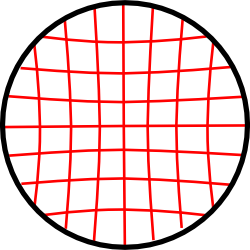
Spherical lenses distort their images, a phenomenon called spherical aberration. This is how a square grid looks when a spherical lens is placed on it.
Central objects are reasonably free of distortion, but overall distortion is minimized in the aptly named aspheric lenses.
(Illustration by the author, using Inkscape.)
Lenses are used to
focus things other than light.
Electron microscopes focus their
electron beams with
electrostatic and
electromagnetic lenses. As I discussed in an
earlier article (Focusing X-Rays, July 20, 2015), a far more difficult task is the creation of lenses for
X-rays, which easily pass through most objects, with their passage somewhat impeded by a material-dependent
attenuation coefficient. This attenuation allows the X-ray imaging of
tooth and
bone in
dental and
medical radiography. The
zone plate, as shown in the figure, is one effective lens for X-rays.
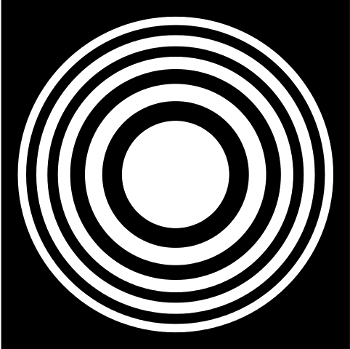
A Zone plate uses the interference of waves to focus X-rays and other forms of electromagnetic radiation. Zone plates can be designed to focus sound waves.
Zone plates are formed as a set of radially symmetric rings that alternate between opaque and transparent. X-rays will diffract around the edges of the opaque zones, and the spacing of the zones is arranged such that Constructive interference produces an image at a focus point.
(Wikimedia Commons image by Tom Murphy VII.)
Reflection can also be used as a lensing principle for X-rays. If X-rays impinge on a
metal surface, they will obey
Snell's law, so there's an
angle for which
total internal reflection is obtained. For X-rays, this
grazing angle is very small, and it ranges from a few
arc-minutes to about a
degree, depending on X-ray
wavelength. This
principle is used to focus X-rays in a
Wolter telescope, named after
German physicist,
Hans Wolter (1911-1978), who
published the idea in 1952.[6] Two
NASA satellite observatories, the
Neil Gehrels Swift Observatory and the
Chandra X-ray Observatory, both use Wolter telescopes.
There's an old
adage that "
Many hands make light work." This was true of the
Multiple Mirror Telescope in which the traditional, huge
mirror of
reflecting telescopes was replaced by an arrangement of multiple mirrors of the same
aperture. Such was also true for an
innovative lens developed at
Harvard University in 2016. This extremely thin optical lens was built from an array of smaller optical elements.[7-8] The array elements were high
refractive index titanium dioxide (
TiO2)
pillars on a
silica glass (
SiO
2)
substrate (see figure).[8] These pillars act as
phase-shifting elements for light. I described this metamaterial lens in a
previous article (Harvard Metamaterial Flat lens, July 4, 2016).
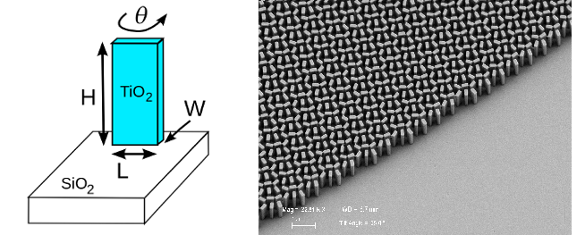
The Harvard metamaterial lens. Left image, the process parameters for titanium dioxide pillars on silica. The phase shift of light through the lens at each point can be adjusted through rotation of the pillars. Right image, a scanning electron micrograph of the metamaterial lens. The titanium dioxide pillars are formed by atomic layer deposition on a silica glass substrate. (Left image, created using Inkscape. Right image, Capasso Lab image via Harvard University.)
The metamaterial lens is just 2
millimeters in
dimension, it has a
numerical aperture of 0.8, and it focuses light with
efficiencies as high as 86%.[8] The focusing was excellent, being
diffraction-limited, but the lens operates at just a particular wavelength of light, and it is out-of-focus at other wavelengths.[8] However, a new metamaterial lens from
researchers at the
University of Utah electrical and computer engineering department operates over a wide
bandwidth, albeit in the
infrared.[9-10]. This lens is described in an
open access article in a recent issue of the
Proceedings of the National Academy of Sciences.[9]
This
long-wave infrared (LWIR) lens has a thickness of just 10
micrometers, and a
weight that's two
orders of magnitude less than that of the equivalent refractive optics.[9-10] Like other metamaterial lenses, this lens is built from many
microstructures, each of which bend light to a focus. Says
Rajesh Menon, an
associate professor at the University of Utah and an
author of the paper, "You can think of these microstructures as very small
pixels of a lens... They're not a lens by themselves but all working together to act as a lens."[10] The research team calls this lens a multilevel diffractive lens (MDL), and it's designed to correct for
optical aberrations, including
chromatic aberrations, in the LWIR band.[9] Its thickness can be of the order of the infrared wavelength.[9]
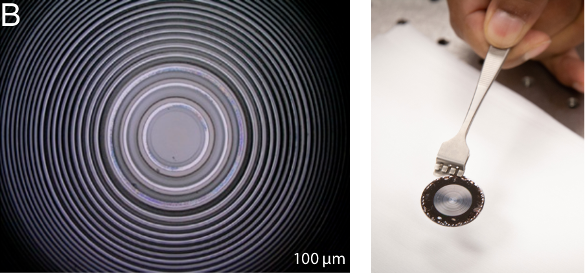
University of Utah multilevel diffractive lens with an 8 mm focal length. Left image, an optical micrograph of the lens from ref. 9, distributed under a Creative Commons Attribution-NonCommercial-NoDerivatives License 4.0 (CC BY-NC-ND). Left image, a photograph of the lens by Dan Hixson/University of Utah College of Engineering.
The lens functions in a spectral band from 8 μm to 12 μm, with chromatic aberrations corrected over that entire LWIR band.[9] At this time, no other
broadband LWIR metamaterial lens has been demonstrated.[9] The first
prototypes exhibited 25%
absorption losses,but good imaging was obtained with a
field of view of 35° and
angular resolution better than 0.013°.[9] These MDLs are
polarization-insensitive, and they can be improved by substitution of lossless, higher-refractive-index materials like
silicon for the
polymers of the prototypes.[9]
Since these lenses are so thin, they can be fabricated from materials with high absorption in the LWIR, such as they polymers used in the prototypes. This would allow inexpensive
manufacturing using
nanoimprint lithography.[9] Since these lenses are so light and have a short focal length, they can be incorporated in cameras on
drones to allow them to fly longer, and
soldiers could have much lighter
night vision equipment.[10] This research was funded by the
National Science Foundation and the
U.S. Office of Naval Research.[10]
References:
- Pliny the Elder, "The Natural History," John Bostock, Trans., Book 37, Chap. 16 ("Smaragdus"), via Tufts University Project Perseus.
- Roger Bacon, "Opus Majus," c.1266, via Boston College website (PDF file).
- Aristotle, Problemata, Translated by E.S. Forster, from vol. 7 of The Works of Aristotle, W.D. Ross and J.A. Smith, Eds., Oxford Clarendon Press, 1927, via archive.org.
- Pliny the Elder, "Naturalis Historia," Latin text, Karl Friedrich Theodor Mayhoff, (Lipsiae: Teubner), 1906, via Tufts University Project Perseus.
- Pliny the Elder, "The Natural History," John Bostock and H.T. Riley, Trans., (London: Taylor and Francis) 1855.
- Hans Wolter "Spiegelsysteme streifenden Einfalls als abbildende Optiken für Röntgenstrahlen (Glancing Incidence Mirror Systems as Imaging Optics for X-rays)," Annalen der Physik, vol. 445, no. 1‐2 (1952), pp.94-114, https://doi.org/10.1002/andp.19524450108.
- Mohammadreza Khorasaninejad, Wei Ting Chen, Robert C. Devlin, Jaewon Oh, Alexander Y. Zhu, and Federico Capasso, "Metalenses at visible wavelengths: Diffraction-limited focusing and subwavelength resolution imaging," Science, vol. 352, no. 6290 (June 3, 2016), pp. 1190-1194, DOI: 10.1126/science.aaf6644.
- Leah Burrows, "Metalens works in the visible spectrum, sees smaller than a wavelength of light," Harvard University Press Release, June 2, 2016.
- Monjurul Meem, Sourangsu Banerji, Apratim Majumder, Fernando Guevara Vasquez, Berardi Sensale-Rodriguez, and Rajesh Menon, "Broadband lightweight flat lenses for long-wave infrared imaging," Proc. Natl. Acad. Sci., October 7, 2019, https://doi.org/10.1073/pnas.1908447116. This is an open access article with a PDF file here.
- Thin to win, University of Utah Press Release, October 8, 2019.
Linked Keywords: Technology; home; transistor; integrated circuit; mobile phone; cellphone; computer; nanoscopic scale; nanoscale; fruits; materials science; advanced material; glass; metal; plastic; electric motor; refrigerator; hair dryer; home appliance; vibrating alert device; household; optics; optical; lens (optics); eyeglasses; camera phone; cellphone camera; tablet computer; laptop computer; disposable product; contact lens; optical lens; history of optics; corrective lens; Pliny the Elder; Roman emperor; Nero; emerald; visual perception; vision; Roger Bacon; Opus Majus; Conrad von Soest (c. 1730 - c. 1422); alps; Wikimedia Commons; protract; grinding (abrasive cutting); polishing; near-net-shape; surface finish; casting; refractive index; epoxy gel; molding (process); temperature; thermal; fluid dynamics; reflow; Ancient Greece; antiquity; pinhole camera; pinhole lens; ray (optics); light ray; symmetry; inverted; image; wall; projection screen; camera obscura; Ancient Greek philosophy; Aristotle (384 BC-322 BC); Problems (Aristotle); Sun; rectangle; rectangular; wicker; basket; circle; circular shape; quadrilateral; rectilinear polygon; rectilinear shape; wicker-work; cone; straight line; water; sphere; spherical; vessel; burning glass; Pliny the Elder (23-79) Naturalis Historia (Natural History); clothing; combustion; ignite; magnification; magnifying; drop (liquid); droplet; Antonie van Leeuwenhoek (1632-1723); microscope; fiber; soda-lime glass; flame; image; phenomenon; spherical aberration; graph paper; square grid; center; central; aspheric lens; Inkscape; focus (optics); electron microscope; cathode ray; electron beam; electrostatic; electromagnetic; X-rays; attenuation coefficient; tooth; bone; dentistry; dental; medicine; medical; radiography; zone plate; interference (wave propagation); interference of waves; electromagnetic radiation; sound wave; radius; radial; annulus (mathematics); ring; opacity (optics); opaque; transparent; diffraction; diffract; constructive interference; point (geometry); Tom Murphy VII; reflection (physics); surface; Snell's law; angle; total internal reflection; angle of incidence; grazing angle; arc-minute; degree (angle); wavelength; physical law; principle; Wolter telescope; Germany; German; physicist; Hans Wolter (1911-1978); scientific literature; publish; NASA; space telescope; satellite observatory; Neil Gehrels Swift Observatory; Chandra X-ray Observatory; adage; many hands make light work; Multiple Mirror Telescope; curved mirror; reflecting telescope; aperture; innovation; innovative; Harvard School of Engineering and Applied Sciences; Harvard University; refractive index; titanium dioxide; titanium; oxygen; column; pillar; fused quartz; silica glass; silicon; wafer (electronics); substrate; phase-shift (wave); metamaterial; process parameter; light; rotation; scanning electron micrograph; atomic layer deposition; Capasso Lab; millimeter; dimension; numerical aperture; efficiency; efficiencies; gaussian beam; diffraction-limited; research; researcher; University of Utah; electrical and computer engineering department; bandwidth (optical); infrared; open access article; Proceedings of the National Academy of Sciences; long-wave infrared; micrometer; weight; orders of magnitude; microstructure; Rajesh Menon; associate professor; author; pixel; optical aberration; chromatic aberration; diffraction; diffractive; focal length; optical micrograph; Creative Commons Attribution-NonCommercial-NoDerivatives License 4.0 (CC BY-NC-ND); prototype; attenuation coefficient; absorption loss; field of view; angular resolution; polarization-insensitive; silicon; polymer; manufacturing; nanoimprint lithography; unmanned aerial vehicle; drone; soldier; night vision equipment; National Science Foundation; U.S. Office of Naval Research.